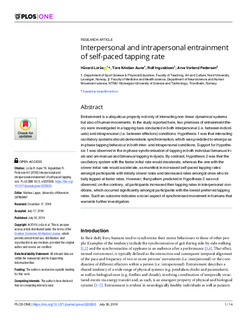| dc.contributor.author | Lorås, Håvard Wuttudal | |
| dc.contributor.author | Aune, Tore Kristian | |
| dc.contributor.author | Ingvaldsen, Rolf Petter | |
| dc.contributor.author | Pedersen, Arve Vorland | |
| dc.date.accessioned | 2019-08-06T08:24:47Z | |
| dc.date.available | 2019-08-06T08:24:47Z | |
| dc.date.created | 2019-08-01T12:43:53Z | |
| dc.date.issued | 2019 | |
| dc.identifier.citation | PLoS ONE. 2019, 14 (7), . | nb_NO |
| dc.identifier.issn | 1932-6203 | |
| dc.identifier.uri | http://hdl.handle.net/11250/2607244 | |
| dc.description.abstract | Entrainment is a ubiquitous property not only of interacting non-linear dynamical systems but also of human movements. In the study reported here, two premises of entrainment theory were investigated in a tapping task conducted in both interpersonal (i.e. between individuals) and intrapersonal (i.e. between effectors) conditions. Hypothesis 1 was that interacting oscillatory systems should demonstrate synchronisation, which was predicted to emerge as in-phase tapping behaviour in both inter- and intrapersonal conditions. Support for Hypothesis 1 was observed in the in-phase synchronisation of tapping in both individual bimanual trials and uni-manual and bimanual tapping in dyads. By contrast, Hypothesis 2 was that the oscillatory system with the faster initial rate would decelerate, whereas the one with the slower initial rate would accelerate, as manifest in increased self-paced tapping rates amongst participants with initially slower rates and decreased rates amongst ones who initially tapped at faster rates. However, that pattern predicted in Hypothesis 2 was not observed; on the contrary, all participants increased their tapping rates in interpersonal conditions, which occurred significantly amongst participants with the lowest preferred tapping rates. Such an outcome indicates a novel aspect of synchronised movement in humans that warrants further investigation. | nb_NO |
| dc.language.iso | eng | nb_NO |
| dc.publisher | Public Library of Science | nb_NO |
| dc.title | Interpersonal and intrapersonal entrainment of self-paced tapping rate | nb_NO |
| dc.type | Journal article | nb_NO |
| dc.type | Peer reviewed | nb_NO |
| dc.description.version | publishedVersion | nb_NO |
| dc.source.pagenumber | 14 | nb_NO |
| dc.source.volume | 14 | nb_NO |
| dc.source.journal | PLoS ONE | nb_NO |
| dc.source.issue | 7 | nb_NO |
| dc.identifier.doi | https://doi.org/10.1371/journal.pone.0220505 | |
| dc.identifier.cristin | 1713650 | |
| dc.description.localcode | © 2019 Lorås et al. This is an open access article distributed under the terms of the Creative Commons Attribution License | nb_NO |
| cristin.unitcode | 194,65,30,0 | |
| cristin.unitname | Institutt for nevromedisin og bevegelsesvitenskap | |
| cristin.ispublished | true | |
| cristin.fulltext | original | |
| cristin.qualitycode | 1 | |
